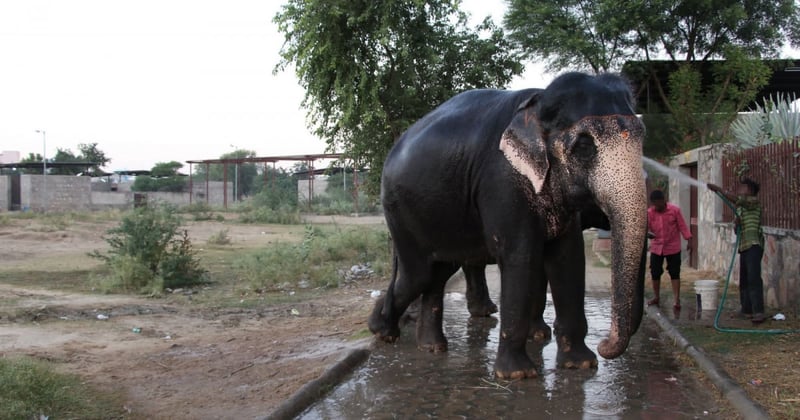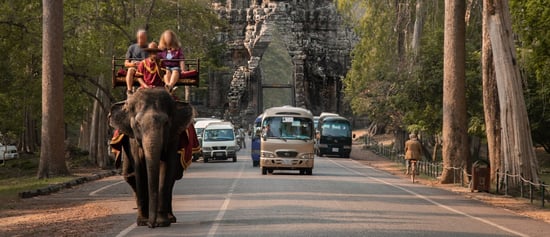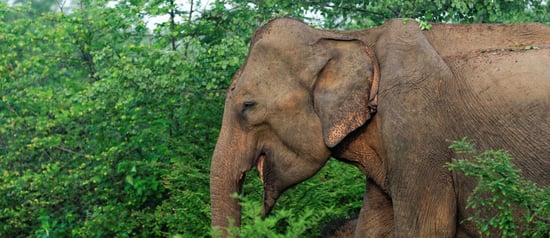
A day in the life of Rani, a working elephant
News
Rani is a 43-year old female Asian elephant. She has likely been doing the same work her entire life: taking tourists up the steep slope to Amer Fort, 365 days a year
Rani, meaning ‘Queen’ in Hindi, is a female Asian elephant who was born to roam free in the lush forests of India. Yet, she spends her days trapped in a concrete stable at the Elephant Village outside of Jaipur.
At 43 years old, Rani has been working at Amer Fort in Jaipur for over 25 years with her current mahout. She doesn’t know any other life than this — taking tourists up and down the steep slope to India’s Amer Fort Palace, day after day.
Like most elephants here, Rani was probably taken from the lush forests of Assam when she was very young. She would have been cruelly trained to behave like a puppet to her captors’ commands before being sold at a cattle fair into a life of misery.
This is a day in her life.
5am
At Hathi Gaon everybody is sleeping, except Rani. How could she? She is standing in her urine and faeces, and she cannot move freely because of the chains and ropes tied to three of her feet, unable to lie down or rest completely. This is torture for her. In the wild, she would take short naps standing up, and would also lie down to sleep for a few hours.
Dawn
Rani is given a quick shower with a hose and a brush, instead of being taken to the nearby lake where she could lie down, splash and play as she would in the wild. When she has been scrubbed clean with an iron brush the orange line crossing her forehead still hasn’t faded. The chemicals in the paint are very strong.
She has sugarcane straw for breakfast. She looks for the greener stems that are juicy and nutritious but there aren’t many. Her diet is very poor compared to what she would eat if she was roaming free in the wild, leaving her weakened.
7am
Rani is ordered back to her stable. She has been trained to obey about 35 commands – move, up, down, sit, photo, lift feet, turn around, etc. She doesn’t resist her mahout. She knows what will happen if she does. She kneels to have her 50-kilogram howdah (saddle) fitted on her back.
With her mahout on her back she then begins the four-kilometre journey to Amber Fort. The sun is strong, even this early, and the roads are chaotic and dangerous. Elephants have been killed in the past by careless drivers. Her foot pads are not made to walk on hot concrete roads and they are cracked and sore as a result.
8am
At the bottom of Amber Fort she meets her counterparts – tens of working elephants lined up to take tourists up the steep slope of the Fort. With no time to rest and recover from the journey, she takes her first customers straight away – maximum two people per ride. It takes about half an hour of slow and painful uphill walk. At the top, the tourists get off and without a pause she walks back down.
She will go up and down four times, without rest or water. She cannot stop or she will receive a beating from her mahout with his bamboo stick – one of the ends is much sharper than the other and causes pain.
Rani earns about USD$130 a day. This income has to support the mahout and his family, as well as the elephant’s owner and his family. Rani cannot take many sick days.
12.30pm
Rani returns to the elephant village along the same dangerous road. But her work for the day is not over. Her heavy howdah stays on her back as she waits to take more tourists for rides around the village in the afternoon. These rides aren’t regulated and mahouts can do as many as they want.
Rani is lonely. She has little to no interaction with other elephants. A solitary life is very unnatural for a female elephant – in the wild she would be part of a close-knit family who would protect and look after each other.
5pm
It is only when the sun goes down that Rani is finally done for the day. Tired, sore and hungry, she is fed more sugarcane straw and chained up for another sleepless night.
Rani’s story is only one amongst many. The next day and every day after will be the same for Rani and the other elephants at Amber Fort. Jaipur elephants are huge and majestic – the only way to force them into this cruel life of rides and entertainment is to break their spirits through beatings and abuse. This life of slavery is a far cry from Rani’s wild counterparts in the lush forests of Assam.
You can help
Elephant attractions across Asia, like rides up Amber Fort, only continue because of tourist demand. If we can end the demand, we can end the cruelty.
You can help stamp out the abuse of elephants in the tourism industry and show travel companies you refuse to be entertained by cruelty.
A solitary life is very unnatural for a female elephant – in the wild she would be part of a close-knit family who would protect and look after each other.
Elephant rides
Today, more than 3,000 elephants are being used and abused to entertain tourists and visitors across Asia.
Our wildlife work
Around the world, wild animals are being exploited. They’re hunted down, trapped and farmed in captivity, all to be sold and abused for entertainment, medicine, fashion, pets and products.




